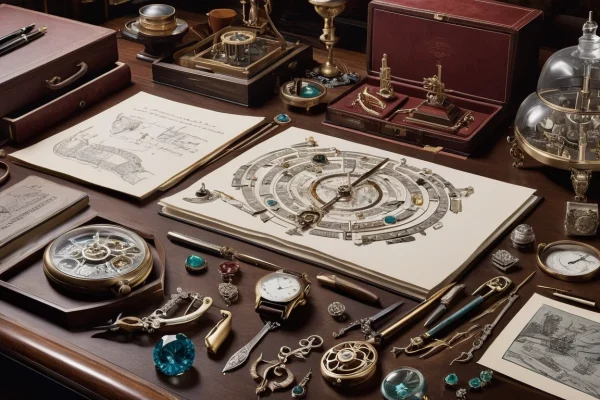Who Inspired the Development of Cartier?

When we think of luxury jewelry, Cartier immediately springs to mind, doesn’t it? But have you ever wondered who inspired the development of Cartier? This iconic brand didn’t just pop up overnight; it was shaped by a myriad of influential figures and events that paved the way for its remarkable legacy. From its humble beginnings to becoming a symbol of elegance and prestige, Cartier’s journey is filled with captivating stories of passion, artistry, and royal connections.
At the heart of Cartier’s inception were its founders, particularly Louis-François Cartier, who had a vision that combined exquisite craftsmanship with innovative designs. His commitment to quality and creativity laid the groundwork for what would become a global luxury empire. As the brand evolved, it was not only the craftsmanship that defined Cartier but also its ability to adapt to the changing cultural landscape.
Royalty played a significant role in elevating Cartier’s status. The brand became a favorite among nobility, with pieces that were not just accessories but statements of power and prestige. For instance, the Duchess of Windsor, a notable patron, had a profound influence on Cartier’s design philosophy. Her unique tastes led to the creation of some of the brand’s most iconic pieces, showcasing how personal preferences can shape an entire legacy.
| Influential Figures | Impact on Cartier |
|---|---|
| Louis-François Cartier | Established the brand’s commitment to craftsmanship. |
| Duchess of Windsor | Influenced design philosophy and iconic pieces. |
| Royal Patrons | Enhanced brand’s luxurious reputation. |
Furthermore, Cartier’s bespoke creations became synonymous with status among the elite. Each piece was tailored to reflect the individual tastes of high-profile clients, making them not just jewelry, but treasured heirlooms. This personalization aspect is what truly sets Cartier apart in the luxury market.
In conclusion, the development of Cartier is a rich tapestry woven from the threads of visionary founders, royal patrons, and artistic collaborations. Each element contributed to the brand’s identity, ensuring that it remains a beacon of luxury and sophistication even today. So, the next time you see a Cartier piece, remember the incredible journey and the inspiring figures behind its creation!
The Founding Visionaries
The story of Cartier begins with its visionary founder, Louis-François Cartier, who established the brand in 1847. His commitment to exceptional craftsmanship and innovative design laid the foundation for what would become one of the most prestigious names in luxury jewelry. Louis-François was not just a jeweler; he was a pioneer who understood the importance of personalization in jewelry, which attracted a clientele that included royalty and celebrities alike. His legacy was carried on by his grandsons, who expanded the brand’s reach and influence across the globe.
The evolution of Cartier under the leadership of the Cartier family can be summarized in the following key aspects:
| Year | Milestone |
|---|---|
| 1847 | Louis-François Cartier founded the brand in Paris. |
| 1902 | Cartier opened its first boutique in London. |
| 1910 | Introduced the iconic “Mystery Clock.” |
| 1920s | Gained fame as “Jeweler of Kings” through royal commissions. |
Cartier’s success is also attributed to its ability to adapt to the changing tastes of society. The brand embraced the Art Deco movement in the 1920s, which not only influenced its aesthetic but also attracted a new generation of clients. The founders’ vision was not just about creating jewelry; it was about creating timeless pieces that tell a story. This philosophy is evident in the intricate designs that have become synonymous with the Cartier name.
As we delve deeper into the brand’s history, it’s essential to recognize the profound impact of its founders. They were not merely artisans; they were visionaries who understood the pulse of luxury and the desires of their clientele. Their commitment to excellence paved the way for the brand’s enduring legacy in the world of high-end jewelry.
Influential Royal Patrons
Throughout its illustrious history, Cartier has been graced by the patronage of numerous royal figures, each contributing to the brand’s luxurious reputation. These influential connections not only elevated Cartier’s status in the jewelry world but also intertwined the brand with the opulence of royal courts. Imagine a world where jewels are not just accessories but symbols of power and prestige—this is the realm Cartier navigated with finesse.
One of the most notable figures in this narrative is the Duchess of Windsor, who had a profound impact on Cartier’s design philosophy. Her penchant for unique and bold pieces led to the creation of some of the brand’s most iconic jewelry. The Duchess was not just a customer; she was a muse, inspiring a collection that transcended traditional designs. Her influence can be seen in the exquisite craftsmanship and innovative styles that Cartier is celebrated for today.
| Royal Patron | Significance | Notable Pieces |
|---|---|---|
| Duchess of Windsor | Inspired bold and unique designs | Windsor Bracelet, Panther Brooch |
| Queen Mary of Teck | Contributed to royal endorsements | Queen Mary’s Diamond Bandeau |
| King Edward VII | Popularized Cartier among European royalty | Various bespoke pieces |
Moreover, Cartier’s bespoke jewelry became a symbol of status among the elite. High-profile clients sought personalized designs that catered to their individual tastes, effectively making each piece a unique work of art. The allure of owning a Cartier piece was not just about jewelry; it was about possessing a slice of history, a connection to the glamorous lives of royals.
In addition to their royal patrons, Cartier’s engagement rings and wedding bands have become synonymous with love and commitment. Couples around the world choose Cartier as their go-to brand for these significant milestones, reinforcing its place in the realm of romantic symbolism. The brand’s legacy continues to thrive, fueled by the stories and connections forged through its royal patrons.
As we explore the rich tapestry of Cartier’s history, it becomes clear that the influence of royal patrons has been pivotal in shaping the brand’s identity. Their tastes, preferences, and demands have not only defined Cartier’s aesthetic but have also cemented its status as a leader in the luxury jewelry market.
The Duchess of Windsor
The Duchess of Windsor, formerly Wallis Simpson, played a pivotal role in shaping Cartier’s design philosophy. Her exquisite taste and discerning eye for elegance transformed the luxury jewelry landscape and cemented Cartier’s status as a premier jeweler. When she donned a Cartier piece, it was not just jewelry; it was a statement, a symbol of sophistication and exclusivity that echoed through the halls of high society.
Her influence was particularly evident in the iconic pieces she commissioned, which showcased her preference for bold designs and unique styles. One of the most notable creations was the “Windsor Bracelet,” a stunning piece that featured a blend of diamonds and emeralds, reflecting her vibrant personality and status. The Duchess’s affinity for bespoke jewelry not only elevated her own style but also established a precedent for personalized luxury that Cartier would become synonymous with.
| Year | Notable Piece | Description |
|---|---|---|
| 1936 | Windsor Bracelet | A dazzling bracelet featuring diamonds and emeralds, embodying the Duchess’s unique taste. |
| 1947 | Panther Brooch | A striking brooch that showcased Cartier’s innovative design, inspired by the Duchess’s love for animals. |
Moreover, the Duchess’s relationship with Cartier was not merely transactional; it was a collaboration of artistic vision and personal expression. Her requests often pushed the boundaries of traditional jewelry design, leading to creations that were both avant-garde and timeless. This partnership helped Cartier to redefine luxury, making it more accessible to the elite, while simultaneously enhancing its reputation as a brand that catered to the whims of the world’s most discerning clients.
In essence, the Duchess of Windsor was not just a patron; she was a muse whose influence rippled through Cartier’s collections, inspiring generations of designers. Her legacy continues to be felt today, as Cartier remains a symbol of love, commitment, and unparalleled craftsmanship.
Custom Creations for the Elite
When it comes to luxury, Cartier knows how to deliver. The brand has long been synonymous with exclusivity, offering bespoke pieces that cater to the unique tastes of the elite. Imagine walking into a room adorned with jewels that reflect not just wealth, but also personal stories and individual style. This is precisely what Cartier achieves with its custom creations.
Each piece is more than just a piece of jewelry; it’s a masterpiece crafted to perfection. From the moment a client approaches Cartier, they are treated to an experience that feels almost royal. The artisans at Cartier work closely with clients to understand their desires, dreams, and inspirations. This collaborative process ensures that the final creation is not just a product, but a reflection of the client’s identity.
One fascinating aspect of Cartier’s custom creations is the variety of materials and techniques employed. The brand sources the finest gemstones, and each stone is selected with care. Whether it’s a diamond that sparkles like stars in the night sky or a rare colored gem that tells a story of its own, Cartier ensures that every piece is as unique as the person wearing it.
| Material | Characteristics | Symbolism |
|---|---|---|
| Diamonds | Brilliant, timeless | Purity, strength |
| Emeralds | Vibrant, luxurious | Love, rebirth |
| Sapphires | Deep, rich hues | Wisdom, nobility |
Additionally, Cartier’s commitment to craftsmanship is evident in every detail. They employ a range of techniques, from traditional hand-setting of stones to modern design innovations, ensuring that each piece is not only beautiful but also durable. This meticulous attention to detail sets Cartier apart in the luxury market.
In a world where trends come and go, Cartier’s custom creations stand the test of time. They are not just jewelry; they are heirlooms, passed down through generations, each carrying with it a rich history and a legacy of elegance. In essence, when you wear a piece from Cartier, you are not just adorning yourself; you are embracing a piece of art that celebrates your individuality.
As a testament to their legacy, Cartier’s custom creations have become a symbol of status among the elite. It’s no wonder that celebrities and royals alike turn to Cartier for pieces that define their style and elevate their presence.
Symbol of Love and Commitment
When it comes to love, few things embody the essence of commitment quite like a Cartier engagement ring or wedding band. These exquisite pieces are not just jewelry; they are symbols of deep emotional connections and promises for the future. The tradition of using rings to signify love dates back centuries, but Cartier has elevated this practice to an art form, creating timeless designs that resonate with couples around the world.
Cartier’s rings are often characterized by their stunning craftsmanship and unique designs. Each piece tells a story, reflecting the personality and style of the wearer. From the iconic Cartier Love Bracelet to the classic solitaire engagement rings, these creations have become synonymous with romance. The brand’s commitment to quality and attention to detail ensure that every ring is not just a piece of jewelry, but a cherished heirloom.
Consider this: what makes a ring truly special? It’s not just the materials or the design; it’s the emotional weight it carries. A Cartier ring is often seen as a promise, a tangible reminder of love’s enduring power. Couples choose Cartier for its reputation and the assurance that their symbol of commitment is crafted with the utmost care.
| Type of Ring | Features | Price Range |
|---|---|---|
| Engagement Rings | Solitaire, Halo, Vintage | $5,000 – $100,000+ |
| Wedding Bands | Classic, Stackable, Custom | $1,500 – $20,000+ |
Moreover, Cartier’s engagement rings are often featured in romantic proposals, making them a part of countless love stories. It’s not uncommon for couples to reminisce about their special moments while wearing a Cartier piece. The brand’s influence extends beyond just jewelry; it has become a cultural icon representing love and commitment.
In conclusion, Cartier’s ability to encapsulate the essence of love in their designs is what makes them a top choice for couples. As they say, “A ring is not just a ring; it’s a promise.” With Cartier, that promise is beautifully crafted and everlasting.
Artistic Collaborations
Throughout its illustrious history, Cartier has consistently embraced the spirit of innovation and creativity, often collaborating with renowned artists to elevate its designs. These partnerships have not only infused the brand with a unique artistic flair but have also positioned Cartier as a cultural icon within the luxury jewelry market. Imagine a canvas where precious metals and gemstones meet the vivid imagination of visionary artists—this is the essence of Cartier’s artistic collaborations.
One of the most notable collaborations was with the famous artist Georges Braque, a pioneer of Cubism. This partnership resulted in the creation of stunning pieces that combined the abstract forms of Cubism with Cartier’s renowned craftsmanship. The blending of these two worlds produced jewelry that was not just an accessory but a piece of art in its own right. Such collaborations have allowed Cartier to push the boundaries of design and redefine what luxury jewelry can be.
| Artist | Collaboration Year | Notable Piece |
|---|---|---|
| Georges Braque | 1930 | Les Oiseaux Brooch |
| Pablo Picasso | 1940 | Picasso’s Necklace |
| Jean Cocteau | 1950 | Cocteau’s Bracelet |
Moreover, Cartier’s collaborations extend beyond mere aesthetics. They reflect a deep appreciation for the cultural movements of their time. For instance, during the Art Deco movement, the brand’s partnership with various artists led to the creation of pieces characterized by geometric shapes and vibrant colors. This era was not just about decoration; it was about making a statement. Cartier’s jewelry became synonymous with the glamour and elegance of the Roaring Twenties, appealing to a clientele that desired more than just luxury—they sought to express their individuality through art.
In conclusion, the artistic collaborations of Cartier have played a pivotal role in shaping its identity. Each partnership has contributed to a legacy of creativity and excellence, ensuring that Cartier remains at the forefront of the luxury jewelry industry. As we look to the future, one can only wonder what exciting collaborations lie ahead for this iconic brand.
The Influence of Art Movements
Art movements have always played a pivotal role in shaping the aesthetics of various industries, and Cartier is no exception. As trends evolved, so too did the designs and philosophies of this iconic jewelry house. From the geometric elegance of Art Deco to the sleek lines of Modernism, Cartier has continuously adapted, ensuring that its pieces not only reflect the times but also set new standards in luxury.
Take, for instance, the Art Deco period, which emerged in the 1920s. This movement was characterized by bold geometric shapes, vibrant colors, and a sense of opulence. Cartier embraced these elements, creating jewelry that was not only visually striking but also symbolized the prosperity of the era. The use of materials like platinum, diamonds, and colored gemstones became a hallmark of Cartier’s Art Deco creations, making them highly sought after by the elite.
| Art Movement | Key Characteristics | Cartier Influence |
|---|---|---|
| Art Deco | Geometric shapes, bold colors, opulence | Iconic pieces featuring diamonds and colored gemstones |
| Modernism | Simplicity, functionality, minimalism | Streamlined designs with a focus on craftsmanship |
Moreover, the influence of Modernism cannot be overlooked. This movement emphasized simplicity and functionality, which resonated with Cartier’s commitment to exquisite craftsmanship. Contemporary designers at Cartier have successfully merged traditional techniques with modern aesthetics, resulting in collections that appeal to today’s luxury consumers. It’s a fascinating dance of past and present, where each piece tells a story of its own.
In conclusion, the influence of art movements on Cartier’s design philosophy is profound. By embracing the spirit of these movements, Cartier has not only remained relevant but has also solidified its reputation as a leader in the luxury jewelry market. It’s like watching a master artist at work, continually evolving while staying true to their roots.
Art Deco Elegance
The Art Deco movement, which flourished in the 1920s and 1930s, left an indelible mark on the world of luxury jewelry, and Cartier was at the forefront of this transformation. Characterized by its bold geometric shapes, vibrant colors, and lavish materials, Art Deco represented a departure from the ornate styles of the past. Cartier embraced this new aesthetic, creating pieces that not only dazzled but also told a story of modernity and sophistication.
One of the most striking features of Cartier’s Art Deco designs is their use of symmetry and balance. The jewelry often showcased intricate patterns and motifs that drew inspiration from various sources, including architecture, nature, and even ancient civilizations. For instance, the iconic Cartier Tutti Frutti collection exemplifies this trend, as it combines vibrant gemstones like emeralds, rubies, and sapphires in stunning arrangements that reflect both elegance and exuberance.
To further illustrate the significance of Art Deco in Cartier’s legacy, let’s take a look at some key elements that defined this era:
| Element | Description |
|---|---|
| Geometric Shapes | Use of triangles, circles, and squares to create visually striking designs. |
| Bold Colors | Vibrant gemstones and enamel work that added a splash of color to every piece. |
| Innovative Materials | Incorporation of new materials like platinum and synthetic stones alongside traditional gems. |
Cartier’s Art Deco creations were not just jewelry; they were statements of identity and style. Each piece was a celebration of the modern age, reflecting the optimism and forward-thinking spirit of the time. It’s no wonder that these exquisite designs continue to captivate collectors and enthusiasts alike, proving that true elegance is timeless.
As we delve deeper into the world of Cartier, it’s essential to recognize how the Art Deco movement influenced not only the brand’s aesthetic but also the broader landscape of luxury jewelry. The elegance and innovation of this era continue to inspire contemporary designers, ensuring that the legacy of Art Deco lives on in every sparkling piece that graces the market today.
Modern Interpretations
When we talk about of Cartier’s iconic designs, we’re diving into a world where tradition meets innovation. Today’s designers at Cartier are not just preserving the legacy of their predecessors; they are reimagining it for a new generation. Just like a classic song gets remixed for contemporary listeners, Cartier’s designs are being adapted to resonate with today’s luxury consumers.
One of the most fascinating aspects of modern Cartier creations is how they blend traditional craftsmanship with cutting-edge technology. For instance, the use of 3D printing allows for intricate designs that were once impossible to achieve. This fusion of old and new creates pieces that are both timeless and forward-thinking.
Consider the following elements that define Cartier’s modern pieces:
- Innovative Materials: Designers are experimenting with alternative gemstones and sustainable materials, reflecting a growing demand for eco-friendly luxury.
- Personalization: Customization is at the forefront, allowing clients to create unique pieces that tell their personal stories.
- Artistic Collaborations: Collaborations with contemporary artists infuse a fresh perspective, making each piece a work of art.
To illustrate how these modern interpretations stand out, here’s a table comparing traditional and modern Cartier designs:
| Aspect | Traditional Designs | Modern Interpretations |
|---|---|---|
| Materials | Gold, diamonds, and classic gemstones | Alternative gemstones, eco-friendly materials |
| Design Philosophy | Ornate and intricate | Sleek, minimalist, and personalized |
| Target Audience | Royalty and aristocrats | Modern luxury consumers seeking individuality |
In essence, Cartier’s modern interpretations are like a breath of fresh air, revitalizing the brand while honoring its storied past. As we move forward, who knows what exciting innovations the future holds for this iconic jewelry house? The journey of Cartier is far from over, and each new piece tells a story that bridges generations.
Frequently Asked Questions
- Who founded Cartier?
Cartier was founded by Louis-François Cartier in 1847. His vision and craftsmanship laid the foundation for what would become one of the most prestigious luxury jewelry brands in the world.
- What role did royal patrons play in Cartier’s success?
Royal patrons, including the Duchess of Windsor, played a crucial role in elevating Cartier’s status. Their love for bespoke designs and luxurious pieces helped cement Cartier’s reputation among the elite.
- How did Cartier’s designs evolve over time?
Cartier’s designs evolved through various art movements, particularly Art Deco and Modernism. These influences brought innovative aesthetics that transformed the jewelry landscape, making Cartier a trendsetter.
- What is the significance of Cartier’s engagement rings?
Cartier’s engagement rings and wedding bands have become symbols of love and commitment, making them a popular choice for couples looking to express their devotion.
- Did Cartier collaborate with artists?
Yes! Cartier has collaborated with renowned artists, infusing its collections with artistic flair and innovative designs that resonate with cultural movements.
- How does Cartier blend tradition with modernity?
Contemporary designers at Cartier skillfully merge traditional craftsmanship with modern aesthetics, appealing to today’s luxury consumers while honoring the brand’s rich heritage.





